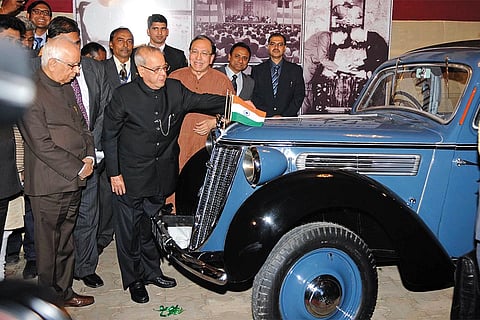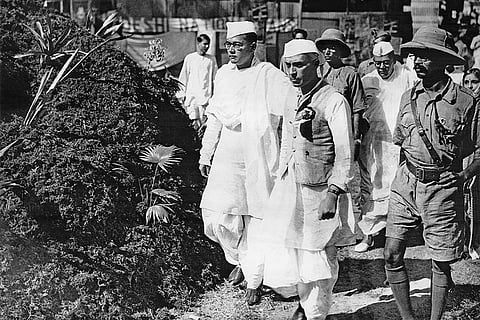What transpired on the cold night of January 16, 1941 is perhaps the only non-controversial episode in the mysterious disappearance of Netaji Subhash Chandra Bose even as far as the great nationalist leader’s own family is concerned. Bose had reportedly had an early dinner with the rest of his family at his home on Calcutta’s Elgin Road informing them that he would be retiring to his room, where he would confine himself for an indefinite period of time for the practice of renunciation. He would not meet anyone. His meals and other essentials could be left for him at the door. Earlier that afternoon his nephew Sisir Kumar Bose, son of his elder brother Sarat Chandra Bose had dropped in too. The 20-year-old medical student had arrived there in the 1937-model, four-door Wanderer which he had recently bought and proudly drove around in. At that time, no other family member realised that what seemed like a regular, innocuous visit by Sisir, was part of an escape plot hatched by his uncle and him. After his release from prison on December 5, 1940, when the revolutionary freedom fighter was placed under house arrest by the British, he had asked his nephew for a favour. It was to transport him secretly out of his house in the dead of night, ensuring that the fourteen-odd sentinels stationed in the premises did not get even a hint of it and drive him to Gomoh Railway Station (now in Jharkhand) from where he would take a train to Delhi. These are the facts of what has come to be known as the “great escape” that Bose’s family has accepted as undisputed.
Nehru, Netaji, Car And Envy
Refurbishing the 1937 Wanderer, in which Bose escaped, has opened faultlines within the family
But what has more or less been kept under wraps so far is that the larger Bose family is completely divided on the issue of what subsequently happened to their illustrious ancestor. One part of the family has unequivocally stated that they have no reason to disbelieve news which had filtered in at that time and which was endorsed by senior Congress leaders including Jawaharlal Nehru, that Bose had died in a plane crash in Taiwan in the year 1945. However, another section of the Bose family vehemently opposes this view, claiming that there is evidence to suggest that Bose did live on, travelling to Manchuria and the Soviet Union, even alleging that keeping alive the theory that he had died was part of a systematic endeavour by powerful and influential leaders of the time who saw Bose’s return as a threat.
Representing this part of the family, Chandra Kumar Bose, Netaji’s grandnephew (son of Subhash’s elder brother Sarat Kumar Bose’s son Amiya Nath Bose) told Outlook, “There was a concerted effort by Congress leaders like Jawaharlal Nehru to try and thwart any possibility of Subhash’s return because they perceived him to be a daunting political rival. His popularity and charisma would dwarf them and this would be extremely inconvenient for them because they had aspirations for the highest positions. Nehru feared that if Subhash returned, his bid to become the first prime minister of India could be challenged. In very simple terms Nehru was downright jealous of Subhash and he did what he could in his power to ensure that Subhash never returns.”
According to Chandra Bose, evidence that Subhash lived after August 1945 was established in a report by the Justice Mukherjee Commission set up in 1999 by the then NDA government to probe the discrepant theories surrounding Netaji’s mysterious disappearance and arrive at a conclusion as to whether he died in a plane crash or not. Justice Manoj Mukherjee, the retired Supreme Court judge, who headed the commission, concluded that while Netaji may have died in the course of the decades that passed since his disappearance, it was not in any plane crash in 1945. In fact, the commission suggests that the plane crash theory was essentially a red herring meant to deceive British forces and ensure Netaji’s escape. The Japanese and Taiwanese governments were reportedly aware of this. “That Nehru would later take advantage of this ruse and establish it as the truth for his own political gain is something that was not foreseen perhaps,” observes Chandra Bose. “But that Nehru was capable of doing that and indeed did do it also becomes clear from suggestions in the Mukherjee Commission report, which points out that the Indian government came to know about this escape from Taiwan and the fact that he did not die there in 1945 from a report of the Taiwanese government as late as in 1956. But Nehru deliberately suppressed this report, not allowing it to come out in to the public domain.”
The Bose family has pointed out that the Indian government is in possession of hundreds of documents and secret files on Netaji and has made repeated appeals to subsequent governments for the “declassification” of these in order for the truth to be revealed. However these have mostly gone unheeded further raising suspicions. The Indira Gandhi government is said to have declined such a demand reportedly with the plea that the revelations would create unrest within the nation and even antagonise other nations.
Indeed, this part of the Bose family does not discount suggestions that there may have been an international effort in which Nehru played a significant role in ensuring that Bose is kept out of India. “There are secret files and documents held with other governments and we have requested Prime Minister Narendra Modi to approach the governments of these nations for the declassification of these,” says Chandra Bose.

Subhash Chandra Bose (centre left) and Jawaharlal Nehru
A Netaji scholar, who had worked in the Soviet Union for a number of years, told Outlook on condition of anonymity, “I had stumbled upon reference in secret files in that country in which no less than Stalin seems to be ordering an official of the Russian government to make suitable arrangements for the accommodation of Bose.” The scholar surmises that Netaji could have “fallen into the hands of the KGB and employed for espionage work or maybe imprisoned. The Justice Mukherjee Commission report too suggested that Bose was detained in a Siberian prison in the late 1950s, based on the account of a Russian general, who is said to have sworn to the commission under oath that he had seen leaked papers of the Soviet-cabinet which dealt with and discussed a “living” Subhash Chandra Bose, one year after his supposed death.
“It pains us to think that Nehru, who was supposed to have been a friend of Subhash would do nothing to ensure his safe and secure return to the homeland he loved so much with full knowledge of his whereabouts,” says Chandra Bose. “On the contrary, he found it more convenient to keep alive the theory that he was dead for his own political gains. And by doing so, he has distorted history.”

Subhash Chandra Bose (centre left) and Jawaharlal Nehru
According to Chandra Bose and this part of the family however, they are what they say “more aghast” by the “denial by members of Bose’s own family that he survived beyond 1945.”
Madhuri Bose, Netaji’s grandniece and daughter of Amiya Nath Bose, told Outlook, “It was a concerted effort by the Congress party to hush up the matter pertaining to Subhash Chandra Bose. The part of the Bose family which continues to perpetuate the falsehood that Bose died in a plane crash in 1945 has on and off belonged to the Congress party. It is unacceptable to us that they have decided to propagate distorted history for political exigencies.” In her book, The Bose Brothers And Indian Independence: An Insiders Account, Madhuri Bose discusses these issues in further detail.
Dr Sugoto Bose, Netaji’s grandnephew and son of Dr Sisir Kumar Bose, who has unequivocally taken the position that existing scholarship points to the leader’s death in a plane crash, declined to respond to the contentions of the other part of the family. The Harvard professor, formerly with the Congress and now Trinamool Congress’s Member of Parliament from the Jadavpur constituency, has recently revamped the 1937 Wanderer in which his father drove his grand uncle on his last journey out of home. Renovated by the vehicle’s car makers Audi, it was unveiled by President Pranab Mukherjee late last week.
It is interesting to note that Pranab Mukherjee too has supported the plane crash theory and had once, according to Netaji researcher and author Anuj Dhar, approached Netaji’s wife, Emilie Schenkl for her permission to receive on behalf of the Indian government the alleged “Netaji ashes” from the Renkoji temple in Japan but was denied. Chandra Bose told Outlook, “Receiving the ashes is tantamount to accepting that Netaji died in the said plane crash, which is something that even his wife did not endorse. The Congress will do anything to establish that plane crash theory.”
The endeavour by Dr Sugoto Bose to restore the car which made the ‘great escape’ possible has both been lauded as well as criticised. Chandra Kumar Bose told Outlook that “While the attempt to revive Netaji’s car is something we have nothing against, certain protocols should have been maintained. There was more need to adhere closely to the original design and colour among other such details. We also object to the manner in which the car was taken for a joy ride. It showed disrespect to Netaji. We have demanded an apology.”
The recent event may have widened the cracks that have been dividing the Bose family for many years. Yet it is undeniable that the acrimony has not been able to corrode the mystery which lies at the very centre of Netaji’s disappearance on that cold January night seven decades ago. If anything, it has reignited it, much like the ignition key of the Audi Wanderer.
Tags